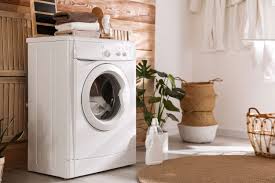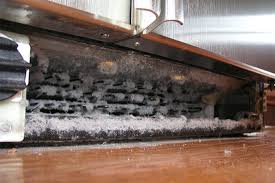Modern homes depend on a variety of appliances that provide comfort, convenience, and functionality from heating and cooling (HVAC) systems to washing machines and refrigerators, these devices work tirelessly to make our lives easier. However, many homeowners overlook regular maintenance until a problem occurs.
Implementing a consistent maintenance routine not only prevents unexpected breakdowns but also optimizes energy efficiency and extends the lifespan of your appliances. The good news is that many essential maintenance tasks require minimal tools and expertise—just a little time and attention.
Let's explore six vital appliance maintenance procedures that deserve a place in your regular home care schedule. For additional tips and suggestions refer to additional blogs found in our Monthly Guide to Home Maintenance.
1. Deep Cleaning Your Washing Machine
Clean laundry starts with a clean washing machine, but over time, lint, detergent residue, and mineral deposits can accumulate in your washer, This affect its performance and can potentially damages your clothes. Always follow the manufacturer's instructions for maintenance and cleaning the machine.
How to clean your washing machine:
- Prepare the machine: Turn off the water supply to your washing machine.
- Clean the drain: Disconnect the drain hose from its connector and empty it into a bucket. Remove any debris or buildup that might be restricting water flow.
- Check the filter: If your machine has an accessible filter, remove it for cleaning.
Scrape off accumulated lint and debris before replacing it.
- Sanitize the drum: Reconnect everything, turn the water supply back on, and run a hot water cycle with either:
Scrape off accumulated lint and debris before replacing it.
- Half a cup of bleach (quarter cup for high-efficiency washers)
- A mixture of two cups of white vinegar and half a cup of baking soda
This simple maintenance routine removes odor-causing bacteria and prevents buildup that could damage your machine or reduce its efficiency.
.
2. Maintaining Your Dryer Vent
Clogged dryer vents not only reduce your appliance's efficiency but also pose a serious fire hazard. Lint accumulation restricts airflow, forcing your dryer to work harder and potentially creating dangerous conditions.
Steps for dryer vent maintenance:
- Disconnect power: Unplug the dryer or turn off the circuit breaker. For gas dryers, also shut off the gas supply valve.
- Access the vent: Locate the vent on the back of your dryer and remove its cover or disconnect the vent hose.
- Clear debris: Remove accumulated lint by hand, disposing of it properly.
- Deep clean: Use a vacuum with a crevice attachment to remove any remaining lint or debris from hard-to-reach areas.
- Reassemble: Replace the cover or reconnect the vent hose securely.
- Restore power: Plug the machine back in or turn on the circuit breaker. For gas dryers, remember to reopen the gas supply valve.
Performing this maintenance annually can significantly improve drying efficiency, reduce energy costs, and minimize fire risks.
.
3. Flushing Your Water Heater
Sediment buildup in your water heater tank can reduce efficiency, increase energy costs, and shorten the appliance's lifespan. Regular flushing removes these deposits and keeps your water heater functioning optimally.
Water heater flushing process:
- Shut down the system: Turn off both the cold water supply and the power to the water heater. For gas models, set the pilot light to its lowest setting or turn it off completely.
- Prepare for drainage: Connect a garden hose to the drain valve at the bottom of the tank and place the other end at a floor drain or outside your home.
- Create airflow: Run hot water from a faucet in another room to help break the vacuum seal in the tank.
- Drain the tank: Open the drain valve and allow the tank to empty completely (typically 30-60 minutes).
- Flush out sediment: With the drain valve still open, turn the cold water supply on and off several times to dislodge and flush out remaining sediment.
- Complete the process: Once the water runs clear, close the drain valve, remove the hose, refill the tank, and restore power or relight the pilot.
This maintenance task, performed annually, can significantly extend yourwater heater's service life and maintain its efficiency.
.
4. Cleaning Refrigerator Coils
Your refrigerator is among the most energy-intensive appliances in your home, accounting for approximately 18-20% of household electricity consumption. Dirty condenser coils force the compressor to work harder, increasing energy usage and potentially shortening the appliance's lifespan.
Refrigerator coil cleaning process:
- Locate the coils: Depending on your refrigerator model, condenser coils may be on the back or at the bottom behind a removable grate.
- Access the coils: Unplug the refrigerator and remove any covers protecting the coils.
- Remove debris: Use a coil brush (available at most hardware stores) to gently dislodge dust, pet hair, and other debris from between the coils.
- Vacuum: Use your vacuum's soft brush attachment to remove the loosened debris.
- Final cleaning: Wipe down the area with a dry microfiber cloth to catch any remaining dust.
Performing this maintenance twice yearly can improve refrigerator efficiency, reduce energy costs, and extend the appliance's operational life.
.
5. Maintaining Your Oven
Regular oven cleaning prevents buildup that can affect cooking performance and potentially create smoke or unpleasant odors. Beyond standard interior cleaning, checking the door seal is an often-overlooked maintenance task.
Oven maintenance tips:
- Regular cleaning: Clean spills promptly to prevent baked-on residue. For deep cleaning, use the self-cleaning function if available, or apply oven cleaner according to product instructions.
- Inspect door seals: Examine the rubber or silicone gasket around the oven door for cracks, breaks, or deterioration.
- Replace damaged seals: If you notice any damage, replace the seal to maintain proper heat retention and energy efficiency.
A well-maintained oven delivers consistent cooking results while using energy efficiently. Checking the door seal annually can prevent heat loss that might otherwise go unnoticed.
.
6. Changing HVAC Air Filters
Your heating and cooling system's efficiency depends significantly on clean air filters. Clogged filters restrict airflow, making your system work harder while potentially reducing indoor air quality.
Air filter replacement process:
- Power down: Turn off your HVAC system before accessing the filter.
- Locate the filter: Common locations include return air ducts or the air handler cabinet.
- Remove the old filter: Note the size and airflow direction indicated on the frame.
- Install the new filter: Insert the replacement filter with the airflow arrows pointing toward the system (away from the return duct).
- Restore power: Turn your HVAC system back on.
Air filters should be checked monthly and replaced every 1-3 months depending on factors like household size, pets, and regional air quality. This simple maintenance task improves system efficiency, extends equipment life, and enhances indoor air quality.
.
Creating a Maintenance Schedule
To make appliance maintenance manageable, consider creating a rotating schedule that spreads these tasks throughout the year:
- Monthly: Check HVAC filters
- Quarterly: Clean washing machine
- Twice Yearly: Clean refrigerator coils
- Annually: Flush water heater, clean dryer vent, check oven door seal
By addressing one maintenance task approximately every other month, you'll avoid the overwhelming feeling of tackling everything at once while ensuring that all your appliances receive proper care.
.
Benefits of Regular Appliance Maintenance
Implementing these maintenance procedures delivers several important benefits:
- Extended appliance lifespan: Appliances maintained in a proper way will not only deliver better service but last longer avoiding early replacement
- Improved energy efficiency: Clean, well-maintained appliances operate using less electricity or gas.
- Lower utility bills: Energy-efficient appliances consume fewer resources, reducing monthly costs.
- Reduced carbon footprint: Efficient operation means less energy consumption and fewer greenhouse gas emissions.
- Prevention of major repairs: Addressing minor issues before they escalate can prevent costly breakdowns.
- Enhanced performance: Maintained appliances deliver better results, whether it's cleaner clothes, colder refrigeration, or more consistent heating.
.
Conclusion
While our appliances silently serve us day after day, they deserve regular attention to continue functioning at their best. By incorporating these maintenance tasks into your home care routine, you'll enjoy more reliable performance, lower operating costs, and longer-lasting appliances.
Remember that maintenance is almost always less expensive and less disruptive than emergency repairs. A small investment of time throughout the year can save significant money and inconvenience down the road, keeping your home running smoothly for years to come.
8 Hidden Warning Signs Your Home May Be Developing Serious Problems









